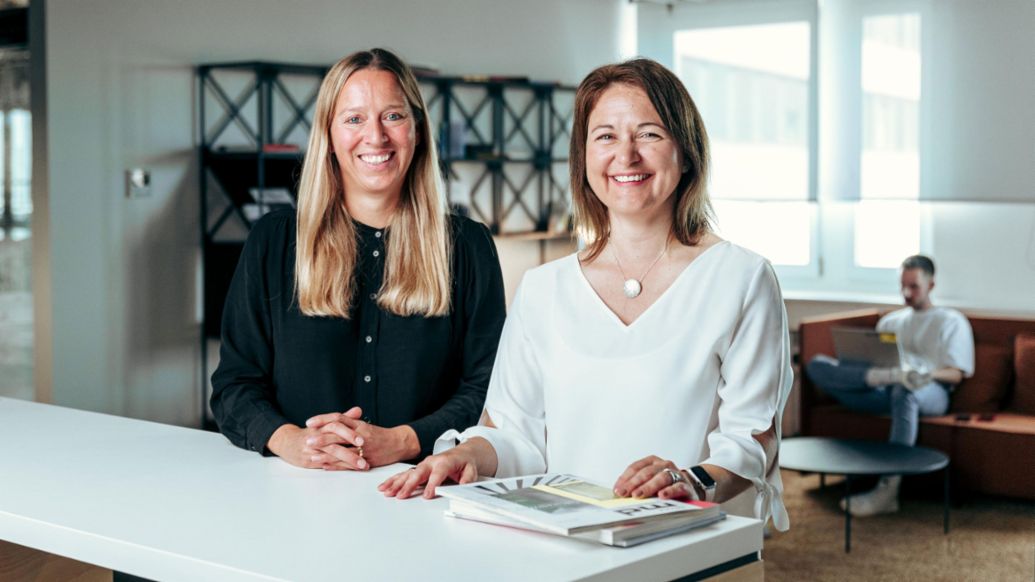“Initially I was in a full-time management position, and I wore myself out completely trying to balance my career and family. It wasn’t how I’d expected things to be,” reflects Christiane Storz, on her first attempt to combine management tasks and home life. The Head of Sales Controlling has worked for Porsche since 2007, and has been a manager since 2012. After her first child was born, Storz started looking for the best way to combine her professional and personal lives, and came up with the idea of job sharing at the sports car manufacturer.

As new working methods for managerial positions were already being discussed in the company at the time, Storz was encouraged to put down on paper a concept for her idea. Following a positive decision by the Porsche Executive Board and a successful search for a suitable tandem, a pilot phase began in the middle of 2014. The job partnership with Kerstin Endress continues to this day. “We’re very grateful to Porsche for this job sharing opportunity,” says Endress. “And we’re proud to have paved the way for further tandems.” More than 20 further pairings have followed.
Combining a family and career presents challenges for many parents. While it was common for grandparents to help with raising children in the past, or one spouse stayed at home, it’s not unusual today for both parents to work or for relatives to live further away. At the same time, younger generations in particular place a high value on a strong work/life balance. As a result, the interest in part-time working models is on the rise – even for managerial positions. Thanks to its job-sharing scheme, Porsche is ensuring that management remains an attractive prospect.
Equal opportunities and broader perspectives
This working model plays an important role in promoting equal opportunities among managers, while at the same time offering those in a managerial position a valuable way of interacting with each other, and the benefit of broader perspectives. At present, job sharing is feasible across all departments and at many levels, and the gender of those involved is irrelevant. The duration of a job share is also flexible: some tandems may share a role for six months, while others can lead a team together for years. The success of the model depends on clear and trusting communication, structured work procedures and the support of the respective team.
Part-time management positions
Job sharing is not about doing a certain percentage of the work and leaving the rest for someone else to pick up. This would be job-splitting, and would more likely cause chaos than add value in positions of responsibility. In the case of job sharing, two people work in tandem using separate time models. They each have the same decision-making and leadership powers, enabling greater consistency and better resolutions. How the tandems divide their work is entirely up to them.
From the perspective of pioneers Storz and Endress, it’s important that both partners have the skills and characters to be able to do the job in question on their own. This ensures decisions of consistent quality and the right standard of work. Of course, the chemistry between those involved must also be good, as job sharing involves spending a lot of time together – and not only dealing with the positive aspects of a job.
Michael Trinkner and Christian Matusek, who have been working together in the Production and Logistics Industrialisation area for about a year, agree.

“We have created a fixed communication structure with a weekly meeting and clear task allocation. To make this work, however, it’s imperative that we communicate with each other in detail and manage criticism well,” explains Matusek. By accepting each other’s respective strengths and weaknesses, the quality and efficiency of the tandem improves. “We complement each other very well when managing together, in terms of the work but also on a personal level.”
Trinkner likes to recall: “Friends told me straight away: You’re doing the right thing. You’ll get to spend so much more time with your children while they’re little.” Matusek adds: “Even a lot of long-established managers told me that they would have gladly used this model, if only it had been around in their time.” The two men also made the decision to job share so that their partners could have careers.
The Matusek and Trinkner tandem concludes at the end of the year, as Matusek is changing jobs within Porsche AG, but the pair certainly aren’t ruling out the idea of starting up new partnerships in the future.
Daniela Fiedler and Sebastian Saxer are also familiar with the model from their respective time in Recruiting. While Saxer’s experience of job sharing had only previously been as an observer, Fiedler was already sharing her role. When her job partner moved to a different department about a year ago, Saxer seized the opportunity to join the scheme. As with many tandems, this decision came about when his children were born and his home life changed. “Job sharing has made my family situation much more flexible,” he says.

For all the partnerships featured here, what’s particularly nice is the support they get in their personal life. Fiedler and Saxer sum up their experiences as follows: “In the beginning, invest time in yourselves as a team. The day-to-day operations are important, but first and foremost the personal connection has to work.”
Matusek has further advice to offer managers interested in following suit: “Ensure that your value systems are in sync. It’s important for you to be working together with a very similar understanding of values.” His colleague Trinkner adds: “Remove the team’s concerns about having two managers. Sometimes employees worry that they won’t be able to take the pressure of having two bosses. Ideally, the two managers should speak with one voice and make consistent decisions. And you also have to get rid of your own fears that working part-time could mean less motivation.”
